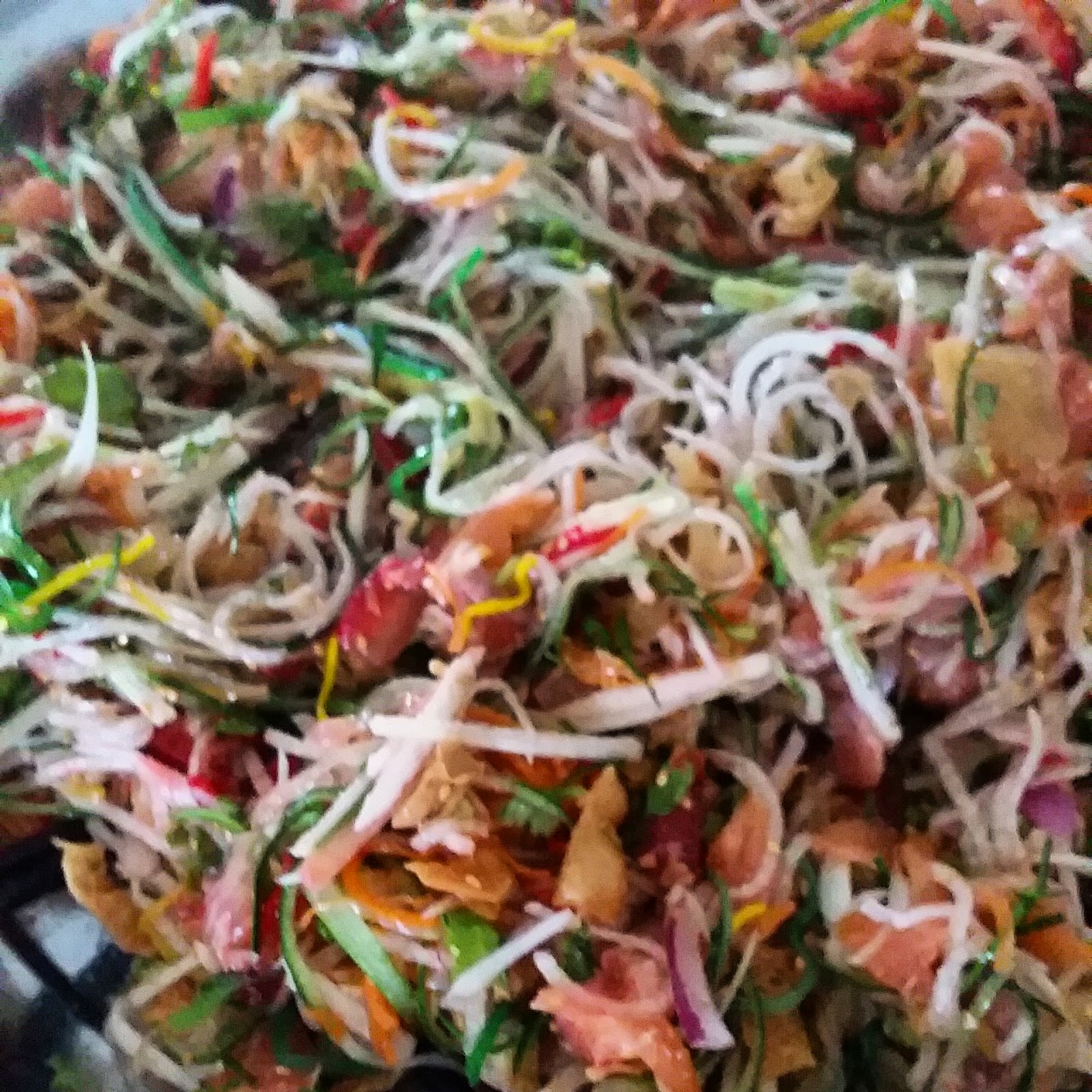Known by so many different names since I goggled it, but I grew up knowing this root vegetable by its common name, as Bang Kuang.
 |
| Bang kuang, Jicama or Yam Bean |
My mom uses Bang Kuang and makes a traditional Hokkien dish called "Jiew Hu Char" and it is a family favourite especially mine!!! Good knife skills are required as the Bang Kuang is a hard root vegetable to cut. If you cook in "bulk" like me, you need strength & good control of the knife to shred it paper thin and fine to get the ultimate "killer dish". You require a lot of it to make a pot full. For some reason, it tastes even more amazing the next day so that means lots of cutting/shredding as I tend to cook a big pot of it. It might look like a mountain high of Bang Kuang before you cook it, but when it is cooked, just bear in mind that it will all shrivel up to less than half of its raw form!!! This dish never fails to grace the dining table and is indispensable especially over festivals in my family home.
 |
| Cooking/simmering on low heat |
I thought you might like to know some of its benefits and something about it, so I have goggled it and summarised it so that it is short and sweet. The root's exterior is yellow and papery, while its inside is creamy white with a crisp texture that resembles raw potato or pear. The flavour is sweet and starchy, reminiscent of some apples or raw green beans, and it is usually eaten raw or can be cooked. In Malaysia it is also used in rojak, gado-gado or even sliced and eaten fresh like a fruit!!! I like to use it in the Rainbow Salad too. (I will blog about this soon).
Bang Kuang/Jícama is high in carbohydrates and a good form of dietary fibre. About 90% of this root is composed of water. Its sweet flavour comes from something called prebiotic. Jícama is very low in saturated fat, cholesterol and sodium. It is also a good source of potassium and Vitamin C.
Now to the most important part of this blog which is the Jiew Hu Char that we have to use Bang Kuang for the bulk of this recipe!!!
I came across a recipe which is pretty similar to mine in ingredients and method of cooking, but I do not use measurements when I cook, so I hope this helps YOU as I am really clueless how much is 80gm of carrots etc!!! I do not know how much it all cooks up to either using the below measurements. Remember, I cook by guesstimation:):)
200g pork belly
3 cloves garlic (chopped)
60g shredded dried cuttlefish (rinsed) You have to cut it vertically otherwise it does not curl up when you fry it.
400g jicama/yambean
80g carrot
1 onion
3 dried shitake mushrooms (soaked in warm water)
1-1/2tsp salt (I prefer to use oyster sauce or fish sauce instead)
1 tsp sugar
A dash of pepper
A dash of black sauce
 |
| The final look of Jiew Hu Char alaSim |
Method:
1. Peel the skin of bang kuang/jicama/yambean and carrot. Slice and cut yambean, carrot, mushrooms and onion finely into thin strips/threads.
2. Boil the pork belly until it’s cooked. Cut the meat into fine strips and set aside. The juices from the pork can be set aside to be used to help the dish slowly simmer.
3. Heat up wok, pour in cooking oil and fry onions and then add in garlic. Stir-fry the garlic until aromatic, add in the dried cuttlefish and continue to stir till you see the cuttlefish curl up.
4. Add in the vegetables and meat. Stir-fry until the vegetables are soft and slowly simmer till tender. (Use pork juices here).
5. Add salt, sugar and pepper to taste.
6. Dish out and serve with rice or you could eat it like an entrée and serve it in a lettuce leaf wrapped up with tee cheo (sweet sauce) and or chili sauce.
 |
| Jiew Hu Char in lettuce leaf |
If you like this Jiew Hu Char dish as much as I do, then you will most probably be eating it by the mouthfuls just on its own!!! There might be lobsters, abalone or prawns on the table, they are all my favourites, but I will be diving into the Jiew Hu Char before all the crustaceans!






















































